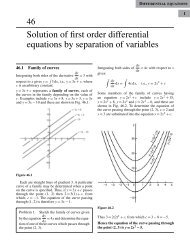vector
Create successful ePaper yourself
Turn your PDF publications into a flip-book with our unique Google optimized e-Paper software.
Vectors 377<br />
5.17 GEOMETRICAL INTERPRETATION<br />
The scalar triple product a .( b <br />
<br />
c ) represents the volume of the parallelopiped<br />
having a , b , c as its co-terminous edges.<br />
<br />
a .( b c ) = a .Area of gm OBDC <br />
= Area of gm OBDC × perpendicular distance<br />
A<br />
between the parallel faces OBDC and AEFG. a<br />
–<br />
= Volume of the parallelopiped<br />
Note. (1) If a .( b <br />
<br />
c ) = 0, then a, b,<br />
<br />
c are<br />
coplanar.<br />
1 <br />
(2) Volume of tetrahedron ( )<br />
6 a b c .<br />
Example 4. Find the volume of parallelopiped if<br />
^<br />
^ ^ ^ ^ ^ ^ ^ ^ ^<br />
a 3 i 7 j 5k, b 3i 7j 3k,<br />
and c 7 i 5 j 3k<br />
are the three co-terminous edges of the parallelopiped.<br />
Solution.<br />
Volume = a .( b <br />
<br />
c )<br />
3 7 5<br />
=<br />
3 7 3<br />
7 5 3<br />
= 108 – 210 – 170 = – 272<br />
Volume = 272 cube units.<br />
= – 3 (–21 – 15) – 7 (9 + 21) + 5 (15 – 49)<br />
Example 5. Show that the volume of the tetrahedron having<br />
<br />
Ans.<br />
A B, B C,<br />
C A as<br />
concurrent edges is twice the volume of the tetrahendron having A , B , C <br />
as concurrent edges.<br />
1 <br />
Solution. Volume of tetrahendron = ( ) .[( ) ( )]<br />
6 A B B C C A<br />
1 <br />
= ( ) .[ ]<br />
6 A B B C B A C C C A <br />
[ C C 0]<br />
1 <br />
= ( ) .( )<br />
6 A B B C B A C A<br />
1 <br />
= [ .( ) .( ) .( ) .( ) .( ) .( )]<br />
6 A B C A B A A C A B B C B B A B C A<br />
1 1 <br />
= [ A.( BC) B.( CA)] A.( B<br />
C)<br />
6 3<br />
<br />
= 2 1 [ ]<br />
6 ABC<br />
= 2 Volume of tetrahedron having A , B , C <br />
, as concurrent edges. Proved.<br />
EXERCISE 5.1<br />
1. Find the volume of the parallelopiped with adjacent sides.<br />
<br />
OA = 3 i j, OB j 2 k, and OC i 5 j 4k<br />
extending from the origin of co-ordinates O. Ans. 20<br />
2. Find the volume of the tetrahedron whose vertices are the points A (2, –1, –3), B (4, 1, 3)<br />
C (3, 2, –1) and D (1, 4, 2).<br />
O<br />
n^<br />
–<br />
b<br />
G<br />
B<br />
–<br />
c<br />
C<br />
E<br />
Ans.<br />
F<br />
D<br />
1<br />
7 3










